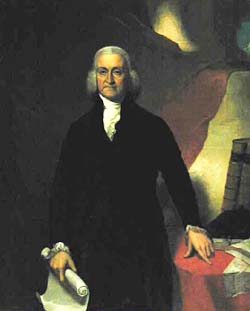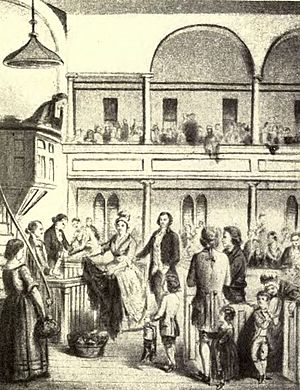Jonathan Trumbull facts for kids
Quick facts for kids
Jonathan Trumbull Sr.
|
|
|---|---|
 |
|
| 16th Governor of Connecticut | |
| In office October 10, 1776 – May 13, 1784 |
|
| Lieutenant | Matthew Griswold |
| Preceded by | Himself (governor of Connecticut Colony) |
| Succeeded by | Matthew Griswold |
| 16th Governor of Connecticut Colony | |
| In office 1769–1776 |
|
| Preceded by | William Pitkin |
| Succeeded by | Himself (governor of State of Connecticut) |
| Personal details | |
| Born | October 12, 1710 Lebanon, Connecticut Colony, British America |
| Died | August 17, 1785 (aged 74) Lebanon, Connecticut, United States |
| Political party | None |
| Spouse | Faith Robinson |
| Children | Joseph Trumbull Jonathan Trumbull Jr. Faith Trumbull Mary Trumbull David Trumbull John Trumbull |
| Alma mater | Harvard University |
| Signature | |
Jonathan Trumbull Sr. (October 12, 1710 – August 17, 1785) was an important American leader. He served as the Governor of Connecticut during the American Revolution. He was one of only two governors who led both a British colony and an American state.
Trumbull was the only governor to support the Patriot cause from the very start of the Revolutionary War. Many places are named after him. These include Trumbull College at Yale University, the town of Trumbull, Connecticut, and Trumbull County, Ohio. Even Jonathan the Husky, the mascot for the University of Connecticut, is named in his honor.
Contents
Early Life and Education
Jonathan Trumbull was born in Lebanon, Connecticut. His parents were Joseph and Hannah Trumble. The family's original last name was "Trumble," but it was later changed to "Trumbull."
Jonathan was a very bright student. He graduated from Harvard College in 1727. After college, he studied to become a preacher for three years. He was allowed to preach in Colchester, Connecticut.
A Career in Public Service
In 1731, Trumbull joined his father's business as a merchant. He became more involved after his brother passed away in 1732.
He began his political career in 1733. He was a delegate to the general assembly for many years. From 1739 to 1740, he served as the Speaker of the House.
Trumbull also had a military career. He was appointed a lieutenant colonel in Connecticut's militia in 1739. During the French and Indian War, he was a colonel in the 12th Connecticut Regiment.
From 1766 to 1769, he was the deputy governor of the Connecticut Colony. After Governor William Pitkin died, Trumbull became the Governor of Connecticut in 1769. He held this important position until 1784. This means he led Connecticut as it changed from a British colony to a U.S. state.
Leading During the Revolution
When British General Thomas Gage arrived in Boston in 1774, he tried to work with Trumbull. Gage wanted Trumbull's help for the British king.
However, after the Battles of Lexington and Concord in April 1775, Trumbull made his choice clear. He refused to help Gage. He told Gage that his troops had made "a most unprovoked attack" on the colonists. Trumbull firmly sided with the Patriots.
Trumbull was a close friend and advisor to General George Washington. He used Connecticut's resources to support the fight for independence. Washington called him "the first of the patriots." When Washington needed more soldiers or food, he often turned to "Brother Jonathan" for help.
In 1775, Trumbull and other officers made Nathan Hale a first lieutenant in the Continental Army. Hale later became famous for his bravery as a spy.
After the War
Jonathan Trumbull was one of only two colonial governors who stayed in office after the colonies became independent. The other was Nicholas Cooke of Rhode Island.
In 1784, Trumbull was made an honorary member of the Connecticut Society of the Cincinnati. This group was for officers who served in the Revolutionary War. He also received special honors from Yale University and the University of Edinburgh.
Family Life
On December 9, 1735, Jonathan Trumbull married Faith Robinson. They had six children together. Many of their children also became important figures in American history:
- Joseph Trumbull (1737–1778) was the first leader of supplies for the Continental Army.
- Jonathan Trumbull Jr. (1740–1809) served as an aide to General George Washington. He later became Governor of Connecticut.
- Faith Trumbull (1743–1775) married General Jedidiah Huntington.
- Mary Trumbull (1745–1831) married William Williams. He was one of the signers of the Declaration of Independence.
- David Trumbull (1751–1822) helped manage supplies for the Connecticut Colony. His son, Joseph Trumbull, also became Governor of Connecticut.
- John Trumbull (1756–1843) became a famous painter. He is known as the "Painter of the American Revolution." He also served briefly as an aide to General Washington.
Jonathan Trumbull Sr. passed away in Lebanon, Connecticut. He is buried in the Old Cemetery there. His home, the Jonathan Trumbull House, is now a National Historic Landmark.
In Historical Stories
Jonathan Trumbull Sr. appears in the book A Little Maid of Old Connecticut by Alice Turner Curtis. In the story, a young girl named Ellie Barlow helps deliver a secret message to Governor Trumbull. He then helps her friend's father find a job. The story takes place in 1777.


